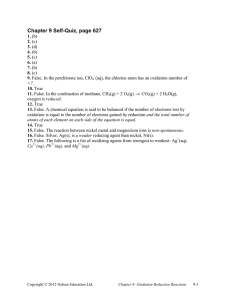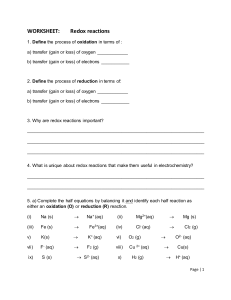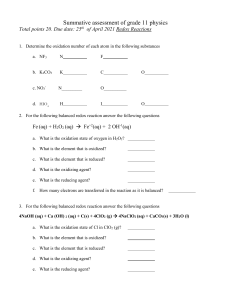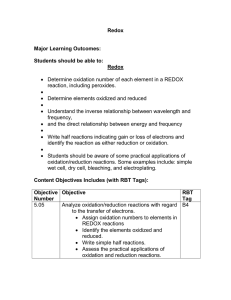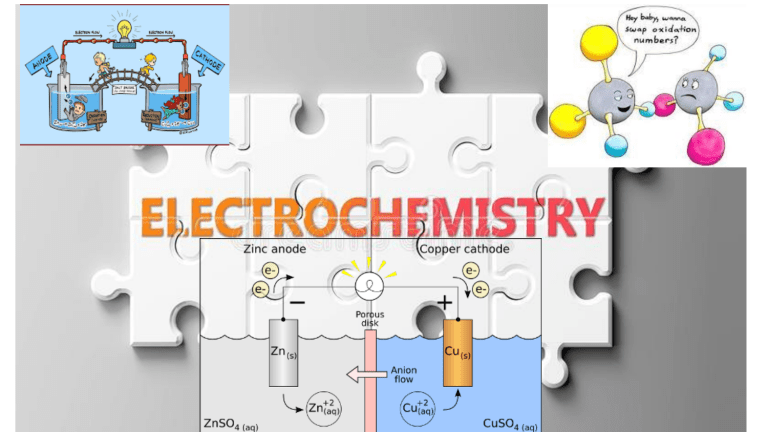
ELECTROCHEMISTRY - WHAT IS IT? ● The branch of chemistry that deals with the relationship between electricity (flow of electrons) and chemical reactions. ● Reactions that involve transfer of electrons (reduction and oxidation, called redox ) ● Spontaneous reactions - galvanic cells or batteries ● Nonspontaneous reactions - Electrochemical cells ● Systems utilizing a redox reaction to produce or use electrical energy Galvanic cell (Voltaic ) ● Spontaneous ● Produces electricity - use activity difference between two metals ● Converts chemical energy to electrical energy ● Composed of two half cells ● Voltage generated Electrolytic Cell ● Non- spontaneous ● Redox reaction forced to occur with external power source ● Converts electrical energy to chemical energy ● Uses electricity to break ionic compounds (electrolysis) Electrochem Terminology ● Species means atom, ion or molecule ● Oxidation number - same as the charge or the valency ● Example → Mg2+, ○ Charge is 2+ ○ Valency is 2+ ○ Oxidation number is 2+ Electrochem Terminology ● Oxidation - a species undergoing oxidation ○ loses electrons ○ Has an increase in the oxidation number ○ Charge becomes more positive Electrochem Terminology Which equation represents the oxidation of a neutral atom of A? 1. 2. 3. 4. A+ → A- + e A → A+ + e A → A- + e A- → A+ + e Answer 2 Reactant A can be a Neutral atom, a cation or anion or even a molecule 1. 2. 3. 4. Anion Anion Neutral Cation A2- → A- + e A- → A + e A → A+ + e A+ → A2+ + e Electrochem Terminology ● Reduction – a species undergoing reduction ○ gains electrons ○ Has a decrease in oxidation number ○ Charge becomes more negative Electrochem Terminology Which equation represents the reduction of a neutral atom of X? Electrochem Terminology ● Oxidizing agent – ○ The species being reduced ○ Gains electrons ○ Causes the other one to be oxidized Electrochem Terminology ● Reducing agent – ○ The species being oxidized ○ loses electrons ○ causes the other one to be reduced Electrochem Terminology Reducing and Oxidizing agent Oxidation/reduction & Oxidizing/and Reducing agent Electrochem Terminology ● REDOX - Short for Oxidation and Reduction ● Both reactions are occuring at the same time ● Each reaction is called a HALF - REACTION Redox reactions never show electrons! Half-rxn’s always have electrons Reduction Half-rxn: Oxidation Half-rxn: Learning Check Identify the species being oxidized and reduced in each of the following reactions: oxidized reduced a. Cr+ + Sn4+ → Cr3+ + Sn2+ A. Cr+ Sn4+ b. 3 Hg2+ + 2 Fe (s) → 3 Hg2 + 2 Fe3+ B. Fe (s) Hg2+ C. As Cl2 c. 2 As (s) + 3 Cl2 (g) → 2 AsCl3 Learning Check Would you use an oxidizing agent or reducing agent in order for the following reactions to occur? a. O2- → O2 a. Oxidizing agent b. Cl2 → Cl- B. reducing agent c. Mn2+ → Mn4+ C. oxidizing agent d. Zn → Zn2+ D. oxidizing agent Learning Check Question - In the reaction: 2Fe2+ + Cl2 → 2Fe3+ + 2Cl- …. Identify the following The Oxidizing Agent: _____________________ The species being oxidized:________________ The reducing agent:______________________ The species being reduced:________________ The species gaining electrons:______________ The species losing electrons:_______________ The product of oxidation___________________ The product of reduction___________________ Learning Check 1. Redox rxn: Pb2+(aq) + Zn(s) → Pb(s) + Zn2+(aq a. The Pb2+ (loses/gains) ________ 2 electrons. b. What is the reduction half reaction? ______________________ c. What is the oxidation half reaction?_______________________ d. e. In oxidation reactions, e’s are _______ and are found on the ___________ side. In reduction reactions, e’s are _______ and are found on the ___________ side. 2. Given the redox reaction: F2(g) + Sn2+(aq) → 2F-(aq + Sn4+(aq) a. Write the oxidation half-rxn:_____________________________ ANSWERS Question 1 a. Gains b. Pb2+(aq) + 2e- → Pb(s) c. Zn(aq) → Zn2+(S)+ 2e d. Lost , right e. Gained, left Question 2. a.Sn2+ → Sn4+ + 2e b. F2 + 2e → 2F-

